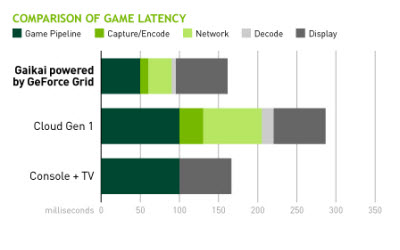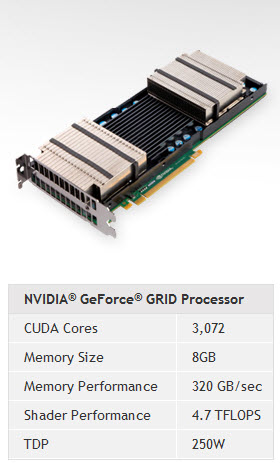GamesBeat: The problem there with the experience is that it’s always improving… The rumored console resolutions are going to be like 4K or so and multiple Blu-ray discs worth of content for their games in the next generation. That’s the kind of thing people were talking about at the Cloud Gaming USA conference at the end there. That puts more of a burden on improving the whole experience for the cloud.
Eisler: Yeah. I think so. Although I’m not so sure that there’s going to be a lot of 4K display screens or TVs available any time soon.
GamesBeat: Sony’s got those TVs for $20,000 dollars …
Eisler: Yeah, exactly. There may be a few people who would want to buy a console for that. 1080p at 60Hz is a pretty awesome experience. The thing about the consoles … they say this is the last console, and I am certainly a believer in that. The last one is almost 10 years old now in terms of the technology.
The good thing about cloud gaming is it’s going to get better every year. One of the reasons we’re investing in it is we see that there are some issues today, but they’re all solvable, and they’re all moving in the right direction. Bandwidth is going up. The cost of server rooms is going down. We’re bringing latency down. The experience will just get better and better every year, to the point where I think it will become the predominant way that people play games.
You can put out multiple Blu-ray discs, but who wants to jockey discs anymore? People don’t want discs in their lives anymore. They want to download everything, and when you’re downloading that kind of stuff, it takes a long time. So we’re also pushing the ability, of course, to play instantly. You don’t have to download anything. You don’t have to update any patches. It’s all maintained for you. You just play.
 GamesBeat: Rob Wyatt, chief scientist at Otoy, said at our 2011 GamesBeat conference that he sees a day when, say, a cloud gaming experience could be faster than a disc-based console system. [chuckles] That they can attack the lag so much and remove it that he thinks that day will come.
GamesBeat: Rob Wyatt, chief scientist at Otoy, said at our 2011 GamesBeat conference that he sees a day when, say, a cloud gaming experience could be faster than a disc-based console system. [chuckles] That they can attack the lag so much and remove it that he thinks that day will come.
Eisler: We did some experiments in that area, around when we launched our product. One of the things we found was that… The consoles, when they launch, they’re rendering the games at 60Hz and the average game has got three frames queued up, so it takes about 50 milliseconds to render a game. As time goes on and more advanced games come, the hardware’s too slow, so they basically take the rendering down to 30Hz. Now you’re spending 100 milliseconds to get a frame out of the console. We also measured a lot of the HDMI inputs on TVs, and the best one that we could find is about 60 milliseconds. So it’s funny. The average gamer playing on an Xbox today with a standard television is probably experiencing 150 to 200 milliseconds of latency, and that’s what they’re used to playing with every day. Because we can always improve the hardware at the server end and we can improve the capture and encode… We can do that portion in about 60 milliseconds and effectively hide the network delay. I think Gaikai showed, when they worked with Limelight, that with a distributed network in the United States, you could get to most homes in about 30 milliseconds. When I was out talking to the Koreans about these things, they’re under 20 to get to houses. People worry about the network latency, but actually, in the whole pipeline, it’s the smallest piece. Our monitors that we work with today are under 10 milliseconds of latency. We think that, working with smart TV manufacturers, we’ll be able to cut that time down. It’s going to be possible very shortly to have a cloud-rendered experience that has lower latency than the current console plus standard television experience.
GamesBeat: Do you improve on the distance that is involved here, too? I think that 1,000 miles to the data center is the limit of what the current cloud guys could do.
Eisler: Yeah. There’ll be a tradeoff versus experience there. The closer you are, the lower latency you’re going to have.
GamesBeat: Just a couple of data centers to cover the whole U.S. would be ideal …
Eisler: That’s one way of doing it, yeah. The alternative is more distributed data centers and giving people an even better experience in terms of lower latency. It could be taken either way. If you say that 150 milliseconds is good enough, then you could probably get down to two data centers. If you want to push through100 milliseconds, then you may want more data centers. We’re working with different providers, going down either one of those strategies.
GamesBeat: Is there something evident about how you guys are doing things differently from AMD?
Eisler: We haven’t heard much from AMD. I think they made a small investment in one of the startups, who actually currently uses Nvidia products…
GamesBeat: They were active with Otoy. They recently invested in CiiNow.
Eisler: Yeah. The thing is, there’s a lot of software that needs to be developed and supported. Nvidia’s invested quite a bit in that. We haven’t seen the cloud gaming software come from AMD get. Really, at this time, the only practical choice that people have is Nvidia.
GamesBeat: So it’s not clear what, say, architectural difference there is right now.
Eisler: Well… On paper, there’s also encoders in the AMD architecture, but I don’t know that anyone’s seen any software for that either. Once the software shows up, then people might be able to get an idea of whether the hardware is good enough or not. Nvidia at that point might be on to our second generation of stuff. It’s just a question of Nvidia investing in stuff in a higher-level integrated way. For a GPU vendor, the revenue from cloud gaming right now is close to zero. It’s just getting off the ground. It’s definitely a bet on the future, to invest your engineers in it. Nvidia so far has been willing to do that. We haven’t seen much investment from AMD in it so far.
GamesBeat: Have you also figured out what you need to do for the ecosystem in order to make it happen? Theoretically you could be operating data centers. Building your own data centers, putting Nvidia-based hardware into them, and leasing them out to whoever wants to use them. Those are investments you could make.
Eisler: Yeah. There’s lots of possibilities, of course. So far, we’ve decided to focus on delivering great boards and software to enable others to be successful in running services and data centers.
GamesBeat: Who do you think’s going to come into this market? The CiiNow folks in particular were hoping to see carriers, cable companies, game companies, game publishers all in some way thinking that they could offer games on the cloud.
 Eisler: We’ve seen it from all of those people. The cable telco companies are interested, both here and abroad. Game publishers are interested. Anybody in the game distribution business. If you’re offering rental services or selling games you’re interested in this. We’ve seen it from all types of people. Some people want to offer more than just gaming. Some people want to also offer virtual desktops or other applications as well. We’ve seen people in the software-as-service business, or anyone building a software app. Again, I think in large part the consumer client has now changed to so many different form factors that are incompatible with general software development on PCs. The ability to stream to any of those desktops is becoming greater. You can stream to any Apple device, whether it’s a Mac or an iOS device. You can stream to televisions. So the reach for a software-as-a-service company, whether it’s gaming or another app, is extended a lot by cloud gaming.
Eisler: We’ve seen it from all of those people. The cable telco companies are interested, both here and abroad. Game publishers are interested. Anybody in the game distribution business. If you’re offering rental services or selling games you’re interested in this. We’ve seen it from all types of people. Some people want to offer more than just gaming. Some people want to also offer virtual desktops or other applications as well. We’ve seen people in the software-as-service business, or anyone building a software app. Again, I think in large part the consumer client has now changed to so many different form factors that are incompatible with general software development on PCs. The ability to stream to any of those desktops is becoming greater. You can stream to any Apple device, whether it’s a Mac or an iOS device. You can stream to televisions. So the reach for a software-as-a-service company, whether it’s gaming or another app, is extended a lot by cloud gaming.
GamesBeat: That speaks to the whole disruptive potential… Everybody’s interested in cloud gaming because it can disrupt businesses.
Eisler: It’s potentially hugely disruptive. That’s why we’re investing in it, and we’re investing in it with our partners. We think it’s a paradigm shift in computing. It’s almost like cloud 2.0. Cloud 1.0 was… Run some sort of master servers and communicate data back and forth. Cloud 2.0, we think, is just render the screen at the server and stream it to everybody. Our early prototypes are showing that that’s very possible to do and has a lot of benefits.
GamesBeat: I wonder if the untimely end of OnLive and cloud 1.0 is scaring some people from cloud 2.0.
Eisler: The naysayers certainly had a field day with the demise of OnLive. But as we’ve discussed, I think a lot of their problems were of their own doing. We still see a lot of potential for the vision of cloud gaming. We wouldn’t do some things the way that OnLive did, and it’s unfortunate that things ended the way they did there, but we don’t see that as a negative for the long-term potential of cloud gaming. We’re still bullish on it.
GamesBeat: I suppose Gaikai’s exit could be viewed more positively, as a great outcome for them …
Eisler: Sure. Clearly Sony believes in it enough to put their $380 million dollars into it. That was equally supportive for those people that are pro-cloud gaming. Anybody who’s in the game console business is clearly awakened to the potential of streaming games to TVs.
GamesBeat: Is it logical to expect more startups in this area, because of different opportunities that arise?
Eisler: There’s already quite a lot of them. There was Gaikai, Onlive, CiiNow, Agawi at the conference in China. You had Cloud Union at the conference.
GamesBeat: G-Cluster …
Eisler: Yeah, G-Cluster in Europe. Playcast. Ubitus
GamesBeat: Otoy, in some ways …
Eisler: Yeah. So we’re approaching 10. I remember in the graphics business, there was originally 30, so we’ve got another 20 to go, I guess. [laughs] And then back down to two. There does seem to be a new cloud gaming middleware company coming up every week or month or so.
GamesBeat: It seems like the middleware folks are trying to provide this one slice of the whole picture. That could enable some better white-labeling or mix-and-matching of different technologies. I wonder if that will help other companies get services off the ground.
Eisler: They perform a system integration function, and they provide some software that enables user accounts and signed games to users and onboarding of games. So they have services that they provide to anyone trying to offer a service. They’re a necessary function in the ecosystem, to bring it together. They’re trying to work with different partners to reach as many potential game subscribers as possible.
 GamesBeat: Given what you know, then, how soon do you think cloud gaming becomes, say, a much bigger part of the consumer market for games?
GamesBeat: Given what you know, then, how soon do you think cloud gaming becomes, say, a much bigger part of the consumer market for games?
Eisler: I think we’ll see a lot happening next year. Our products are sampling to the partners now. They’re building their middleware services based on them, and they’re starting to interact with telcos and other gaming-as-a-service providers. A lot of it is actually outside this country so far. Asia is leading the way. But that will come back here next year. We’ll see it gain momentum throughout next year. But if I look out five years, I think it could be a significant portion of the way people play games.
GamesBeat: How much resources is Nvidia putting behind it?
Eisler: It’s one of the major strategic initiatives in the company. There’s well over 100 people working on it to some degree. Whether it’s on the hardware, the software, the firmware and driver level… There’s a lot of people here that are working on it in some fashion or another.
GamesBeat: Some people have pointed out that if you sell a lot of graphics cards into data centers, you may not sell so many to consumers anymore. That’s a tradeoff.
Eisler: Yeah. As we discussed before, as the screens move to higher resolutions like 1440 or 2K and people want that kind of… I mean, we talk about 100 to 150 milliseconds of latency in cloud gaming. GeForce gamers are playing with 50 milliseconds of latency. There’s still a gap to that GTX experience for the hardcore gamer. I think it’ll be 10 years before we have to worry about them switching over to the cloud. They’re pretty particular about their gaming experience. I don’t think we have to worry too much about that right now. That also improves dramatically from generation to generation. We see this more the opposite way, really, as expanding the market for GeForce. I think it will attract new users, because it’s easier to play and you can now play PC games on any device, not just on a PC that you have to set up yourself. For the most part, it expands the market for Nvidia more than it takes away.
![]() CloudBeat 2012 is assembling the biggest names in the cloud’s evolving story to learn about real cases of revolutionary cloud adoption. Unlike other cloud events, customers — the users of cloud technologies — will be front and center. Their discussions with vendors and other experts will give you rare insights into what really works, who’s buying what, and where the industry is going. Register now and save 25 percent! The early-bird discount ends September 14.
CloudBeat 2012 is assembling the biggest names in the cloud’s evolving story to learn about real cases of revolutionary cloud adoption. Unlike other cloud events, customers — the users of cloud technologies — will be front and center. Their discussions with vendors and other experts will give you rare insights into what really works, who’s buying what, and where the industry is going. Register now and save 25 percent! The early-bird discount ends September 14.
VentureBeat's mission is to be a digital town square for technical decision-makers to gain knowledge about transformative enterprise technology and transact. Learn More

